where μ0 = 4*π*10^-7 H
sdsu-physics.org
Inductors and Faraday's Law
We start by contemplating magnetism: there are two sources for magnetism. Ferromagnetic materials and current flowing through a wire, particularly in the shape of a solenoid. And the current can be of two sorts: AC or DC. Below shows equations that allow you to compute the B field in space based on current flowing through a wire, and the wire's geomety (path through 3D space).
where μ0 = 4*π*10^-7 H
sdsu-physics.org
From the cross product above image: What do the B fields lines look like due to current in a straight wire? due to current in a wire going in a loop, or a helix? From a more mathematical point of view, note that B fields have a non-zero curl.
Griffiths p. 295:

Comparison to electric fields: It's easy to see that an isolated proton or electron can have electric field lines radiating from it. What so with circular magnetic field lines? Well for one, there can be no such thing as magnetic monopoles: "north" or "south" particles that account for B fields.
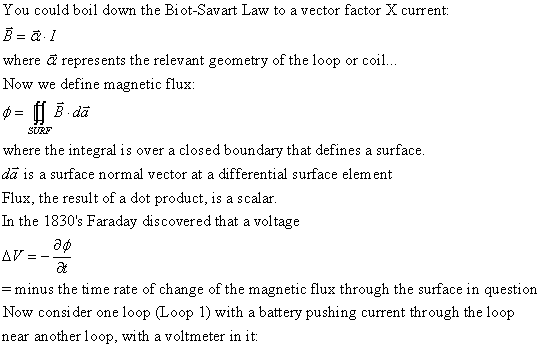
 cnx.org
cnx.org
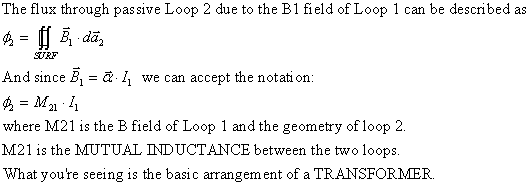
Now if you close your eyes and picture the magnetic
flux lines of a helix of enameled wire, perhaps wound around an iron core, you
can appreciate the SELF INDUCTANCE L of that coil. If the magnetic field is
time-changing (sinusoidal say) then Faraday's Law kicks in and a BACK EMF (electro-motive
force) is generated that resists the battery causing the current flow through
that one coil. The coil just described is an INDUCTOR... Why the letter L for
inductance? ...ask the French...
Faraday's
Law

Our 3 Ohm's Law type equations are now
V = I * R
Q = C * V
φ = L * I where L is inductance, measured in Henrys.
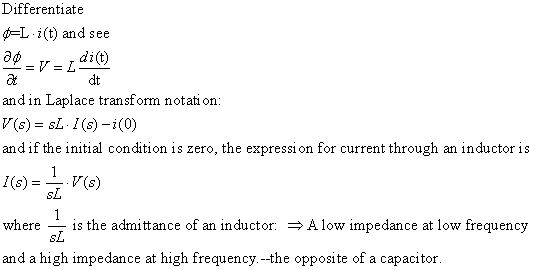
what about minus sign in Faraday's Law? from Griffiths:
"Inductance (like capacitance) is an intrinsically positive quantity. Lenz's
Law, which is enforced by the minus sign, dictates that the EMF (voltage) is
in such a direction as to oppose any change in current. For this reason, it
is called a back EMF. Whenever you try to alter the current in a wire
you must fight againt this back EMF. Thus inductance plays somewhat the same
role in electric circuits that mass plays in mechanical systems: The greater
L is, the harder it is to change the current, just as the larger the mass, the
harder it is to change an object's velocity."
And consider a voltage source in series with L and R... to see the sign flipped... (Griffiths & video)
Exampe on video of an analyzed circuit of a current source in parallel with an inductor, connected to a capacitor, then a load resistor... solved with the node admittance matrix.
Inductors in series add, in parallel they are summed like resistors in parallel: 1/LT = 1/L1 + 1/L2 + 1/L3 + ...
Fabrication of coils with enameled magnet wire:
Energy: An ideal inductor doesn't dissipate energy, it stores energy; from
the definitions of power P and energy U:
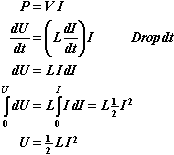 faculty.wwu.edu
faculty.wwu.edu
If you unplug a motor (such as in a vacuum cleaner) while it's running you can see at the wall plug a spark jump across, representing the discharge of energy stored in the motor coil.
As an energy storage element in a circuit an inductor adds another "order" to the differential equation(s) describing the circuit. The worked example on video is a second order circuit, where and underdamped response may occur.
How
a transformer works: primary, secondary windings
Vout =(num_sec_wind/num_pri_wind)*Vin... Vin
muct be AC--> sinusoidals...
The primary and secondary windings are related by their mutual inductance,
M.
Transformers
in signal isolators: Analog Devices isolation amp
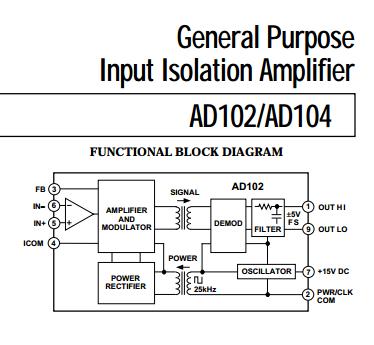 Price (model
210) ~80$ >> LF353, $1
Price (model
210) ~80$ >> LF353, $1
How
transformers work:
http://www.scienceaid.co.uk/physics/electricity/electromagnetism.html
Demo solenoid: moving
an iron piston with electrically-induced magnetic field B
Power
supply = transformer + rectifier + LP filter + regulator
Demo
of E3631A limiting current and voltage with 4.7 ohm resistor
on 25v supply. resistance of jumpers! 2 ohms...
How a switching
power supply works to have no loss at the regulator.
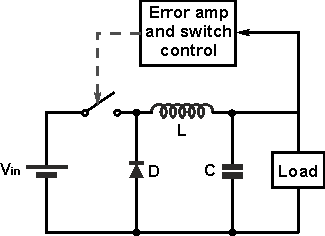 http://www.radio-electronics.com/
http://www.radio-electronics.com/
The role
of inductance in a defibrillator. Second order system, overdamped please!
"In 1959 Bernard Lown commenced
research in his animal laboratory in collaboration with engineer Barouh Berkovits
into an alternative technique which involved charging of a bank of capacitors
to approximately 1000 volts with an energy content of 100-200 joules then delivering
the charge through an inductance such as to produce a heavily damped sinusoidal
wave of finite duration (~5 milliseconds) to the heart by way of paddle electrodes."
WIKIPEDIA
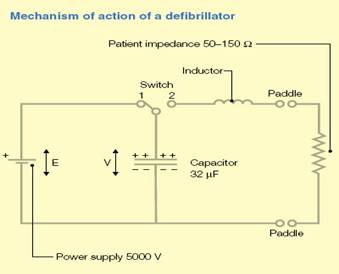 resistor on right represents the heart in the torso
resistor on right represents the heart in the torso
http://www.unc.edu/~goettsch/
Lorentz
force Law: Another
way magnetism can generate mechanical force:
![]()
v X B will (in a later lecture) help explain how a DC
electric motor armature develops torque...
Other
"magnetic" examples:
* Magnetoencephalography = MEG vs EEG
* Magnetic drug delivery
* Isolation transformers
* magnetically controlled shunts for hydrocephalus
* birds
navigating during migration over open ocean on a cloudy night...Alaska
to New Zealand...
* Can humans sense magnetic fields? No.